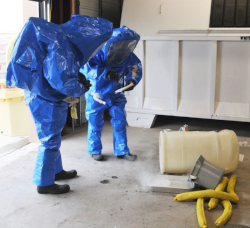The Exclusion Zone
The Exclusion Zone, also called the "Hot Zone" is the area where contamination does or could occur.
The primary activities performed in the Exclusion Zone are:
- site characterization, such as mapping, photographing, and sampling
- installation of wells for groundwater monitoring
- cleanup work, such as drum movement, drum staging, and materials bulking
The Exclusion Zone can be subdivided into different areas of contamination based on the known or expected type and degree of hazard or on the incompatibility of waste streams. This allows more flexibility in safety requirements, operations, decontamination procedures, and use of resources.
The personnel working in the Exclusion Zone may include the Field Team Leader, the work parties, and specialized personnel such as heavy equipment operators.
All personnel within the Exclusion Zone should wear the level of protection (A, B, C, or D) required by the Site Safety Plan. Within the zone, different levels of protection may be justified based on the degree of hazard presented.
- The level of personal protection required in each subarea should be specified and marked.
- The required level of protection in the Exclusion Zone varies depending on the job assignment. For example, a worker who collects samples from open containers might require Level B protection, while one that performs walk-through ambient air monitoring might only need Level C protection.
- When appropriate, different levels of protection within the Exclusion Zone should be assigned to promote a more flexible, effective, and less costly operation, while still maintaining a high degree of safety.
Knowledge Check Choose the best answer for the question.
1-5. Which of the following is the area where contamination does or could occur?
You forgot to answer the question!

